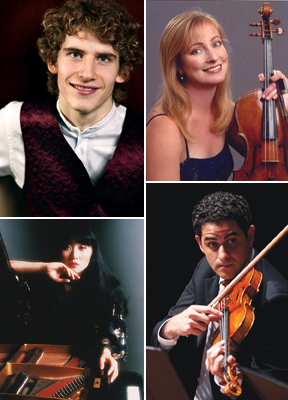DISTINGUISHED CHAMBER MUSIC FROM NEW YORK
Chamber Music Society of Lincoln Centre, Works by Beethoven, Jalbert and Brahms,Vancouver Playhouse, January 23, 2011.
Musicians of the New York-based Chamber Music Society of Lincoln Centre have been regular visitors to Vancouver. While previous concerts have featured a variety of its long-standing members, this concert highlighted three of its promising young participants, under the inspirational guidance of co-artistic director, pianist Wu Han. These were American violinist Arnaud Sussmann and violist Mark Holloway, and Scandinavian cellist, Andreas Brantelid.
This group combined for particularly fresh music-making, perhaps revealing the innocence of first discovery that only young musicians can have. They also produced a less American, more international, sound than their predecessors; certainly strong and thrustful when needed but full of refinement and sensitive touches too. The ensemble work was excellent; everyone listened carefully to each other and paid close attention to dynamic markings.
The opening Beethoven String Trio Op. 9, No 2 may be early Beethoven but it is a well structured, enjoyable work with considerable variety. The three string players gave a crisp, attentive performance that judged the scale of the work very well. The more soloistic passages revealed just how talented each player was, cellist Andreas Bratlelid in particular showing a wonderful expressive spontaneity.
It is perhaps a big jump to the Piano Trio of Pierre Jalbert, a highly-respected contemporary American composer, originally of French-Canadian descent. This was definitely a ‘very modern’ composition, featuring many sophisticated instrumental techniques, rhythmic subtleties, and jazz episodes. Yet, largely due to the commitment of pianist Wu Han, it communicated its emotional content strongly and directly. Its themes were elemental, moving from the rhythms of ‘birth’ in the first movement to lament and prayer in the second. The ‘lament’, actually dedicated to Mother Teresa, featured a range of gripping and heartfelt string passages similar in raw intensity to late Shostakovich. This was one modern composition that had immediate impact and was warmly received by all.
The final Brahms Piano Quartet, Op. 25 allowed all musicians to play together. The quartet indeed is a popular one, not least because of the exciting drive of its ‘Hungarian gypsy’ rondo finale. In fact, all parts of the work show immense craft, being strongly structured, emotionally rich, and full of variety. The performance of the opening movement was one of the best I have heard, combining a broad cumulative power with a natural lyricism and sensitivity. While the second movement might have been slightly more varied, and the slow movement was a little too eager to express romantic sentiment, the playing was always alive, and the popular finale combined strength, drive and sparkle to produce a pretty overwhelming close.
I think that this concert added up to a real musical experience. Each musician seemed fully involved with the music they were playing, and to see how Wu Han galvanized the natural artistry of these young players into such a distinguished corporate response was enriching. Let’s hope the synergy continues!
© Geoffrey Newman 2011
